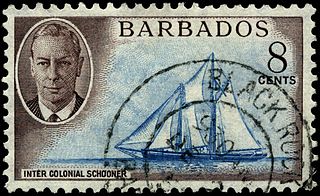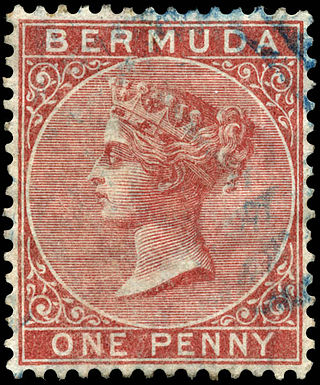
The Penny Black was the world's first adhesive postage stamp used in a public postal system. It was first issued in the United Kingdom on 1 May 1840 but was not valid for use until 6 May. The stamp features a profile of Queen Victoria.
East Africa and Uganda Protectorates was the name used by the combined postal service of the British protectorates, British East Africa and Uganda, between 1 April 1903 and 22 July 1920.

The Penny Red was a British postage stamp, issued in 1841. It succeeded the Penny Black and continued as the main type of postage stamp in the United Kingdom of Great Britain and Ireland until 1879, with only minor changes to the design during that time. The colour was changed from black to red because of difficulty in seeing a cancellation mark on the Penny Black; a black cancellation mark was readily visible on a Penny Red.
Each "article" in this category is in fact a collection of entries about several stamp issuers, presented in alphabetical order. The entries themselves are formulated on the micro model and so provide summary information about all known issuers.
Each "article" in this category is a collection of entries about several stamp issuers, presented in alphabetical order. The entries themselves are formulated on the micro model and so provide summary information about all known issuers.

John Harry Robson Lowe was an English professional philatelist, stamp dealer and stamp auctioneer.

Sir Edward Denny Bacon was a British philatelist who helped with the enlargement and mounting of collections possessed by rich collectors of his time and became the curator of the Royal Philatelic Collection between 1913 and 1938.

Mauritius, a small island in the southwest Indian Ocean, is important to the world of philately for a number of reasons. Its first two postage stamps issued in 1847, called the "Post Office" stamps, are of legendary rarity and value. They were the first stamps issued in any part of the British Empire outside of Great Britain. The unique cover bearing both “Post Office” stamps has been called "la pièce de résistance de toute la philatélie" or "the greatest item in all philately". The cover was sold at auction, in Zurich, on 3 November 1993, for 5.75 million Swiss francs, the equivalent of about $4 million – the highest price ever paid for a single philatelic item up to that time. In addition, Mauritius is well known for the subsequent locally produced issues known as "primitives," also prized by collectors.

This is a survey of the postage stamps and postal history of Gibraltar.

This is a survey of the postage stamps and postal history of Barbados.

The colony of the British Virgin Islands has issued its own stamps since 1866. The first Post Office was opened in Tortola in 1787. At the time postage stamps were not yet invented, and it was not until 1858 that a small supply of adhesive stamps issued by Great Britain depicting Queen Victoria were utilized by the local Post Office. These stamps were cancelled by an A13 postmark and are extremely rare so cancelled.

This is a survey of the postage stamps and postal history of Cape of Good Hope.

This is a survey of the postage stamps and postal history of Dominica, an island nation in the Caribbean Sea. Claimed by France in the 17th century, it was later awarded to Great Britain, becoming independent in 1978.

Nevis, a British colony in the Leeward Islands, began issuing stamps in 1861.
Saint Kitts and Nevis is an island country in the Leeward Islands, consisting of the islands of Saint Kitts and Nevis. In 1883, St. Kitts, Nevis and Anguilla were united into one colony. Anguilla formally separated from the union in 1980.

St. Lucia a former British dependency in the Windward Islands began using stamps in 1860. It achieved Associated Statehood on 1 March 1967. In 1979, it gained independence.

This is a survey of the postage stamps and postal history of Saint Helena.

Bermuda, a group of islands in the North Atlantic Ocean, was previously uninhabited when the British established a settlement in 1612.
This is a survey of the postage stamps and postal history of Grenada.
Ezekiel Victor Toeg FRPSL was a British solicitor and philatelist who specialised in the postage stamps and postal history of the British West Indies (BWI) and Caribbean. His collection of Antigua won two gold medals at international stamp exhibitions and included a 1693 letter to London that was described in 1990 as the earliest known letter from the island. He wrote a book on the adhesive fees stamps of the Leeward Islands (1991) and completed a survey of the stamps and postal history of the island of Dominica to 1935 (1994). He was president of the British West Indies Study Circle (BWISC) from 1968 until his death in 2010.


















